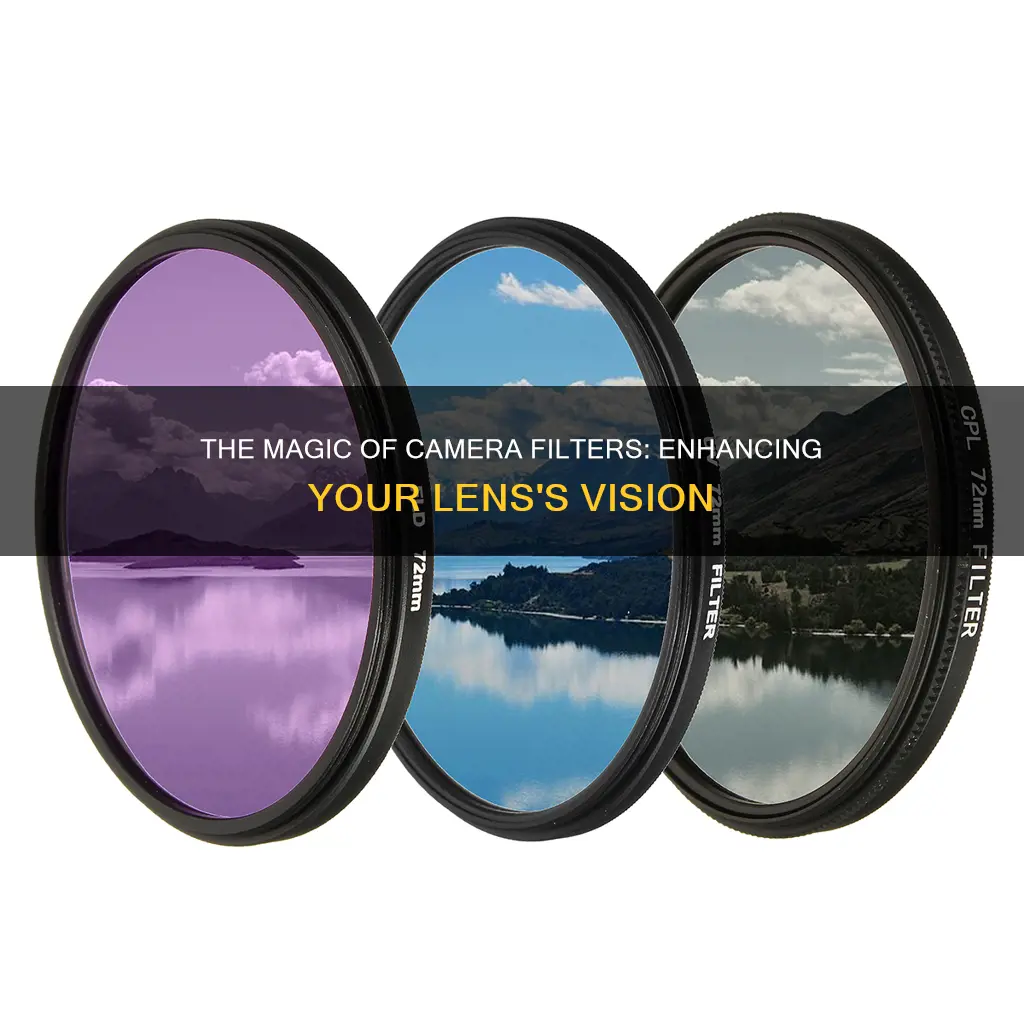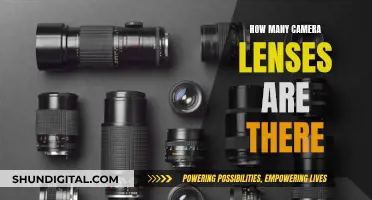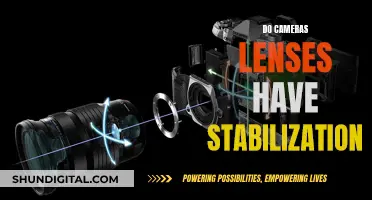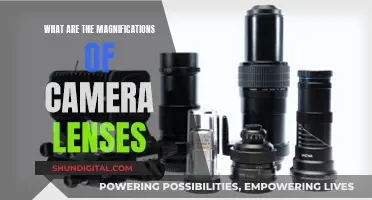
Camera lens filters are small pieces of glass or resin that attach to the front of a lens. They are used to protect the camera lens, alter the characteristics of light passing through the lens, or add special effects and colours to an image. Filters are available in two types: screw-in filters and slot-in filters. Screw-in filters fit directly onto the lens, whereas slot-in filters are placed in a holder attached to the lens.
Filters are used to manage tricky lighting conditions, enhance colours, reduce light coming into the lens, and more. Each lens filter serves a specific purpose and is built to deliver a specific effect. Some common types of filters include UV/haze filters, polarising filters, neutral density filters, graduated neutral density filters, and warming/cooling filters.
| Characteristics | Values |
|---|---|
| Purpose | Protection, altering light, adding effects and colours |
| Types | Screw-in, slot-in, UV, polarising, neutral density, graduated neutral density, colour balancing, soft focus, B&W, special effects, warming, cooling, infrared, close-up, FLD |
| Shape | Circular, square, rectangular, drop-in |
| Material | Glass, gelatin, resin, plastic, polyester, polycarbonate |
What You'll Learn

Filters can protect lenses from dust, scratches, and cracks
UV filters, in particular, are often used for this purpose as they are clear and do not affect the image quality. They are also useful for reducing haze and unwanted purple fringing in digital photography. While modern digital sensors are not sensitive to UV light, UV filters can still provide valuable protection for lenses.
In addition, some lenses are not fully weather-sealed without a filter attached. Therefore, using a filter can help to ensure that your lens is protected from the elements. It is worth noting that cheap filters may reduce image quality, so it is recommended to invest in high-quality filters from reputable brands.
Another way that filters can protect lenses is by making them easier to clean. Filters are typically cheaper and easier to replace than lenses, so it is preferable to clean marks and dust from a filter rather than the lens itself.
Finally, filters can help to reduce glare and reflections, enhancing the final image. This can be particularly useful when shooting near water or other reflective surfaces.
Overall, while filters are not essential and some photographers choose not to use them, they can provide valuable protection for lenses and improve image quality in certain situations.
Polarized Filters: Enhancing Camera Lens Performance and Image Quality
You may want to see also

Filters can enhance colours and reduce reflections
Filters can be used to enhance colours and reduce reflections in a number of ways. Firstly, they can correct and enhance colours in an image. For example, colour-correcting filters can be used to make an image look more beautiful, accurate and realistic. They can also be used to bring out certain hues in a scene, such as the colours of a rainbow.
Filters can also be used to reduce reflections and glare, which can be particularly useful when shooting through glass or water. This is where polarizing filters come in. They saturate the colours in an image and reduce reflections, making them ideal for shooting landscapes. They can darken skies, make colours pop and eliminate glare.
Another way that filters can enhance colours is by altering the colour temperature of a scene. They can also enhance colour and contrast for a more vibrant image. For example, red filters are often used in black and white photography to darken skies and emphasise clouds, adding drama to landscapes. Yellow filters, on the other hand, can be used to add a warm, golden tone to images.
Filters can also be used to reduce the intensity of light coming into the lens without altering the colour of the resulting image. This is where neutral density filters come in. They allow photographers to use slower shutter speeds without overexposing the image, which can be useful for creating motion blur effects.
The Ultimate Guide to Understanding Camera Lenses Variety
You may want to see also

Filters can be used to manage lighting conditions
Another way that filters can help manage lighting conditions is by minimising glare and unwanted reflections, especially from water and glass surfaces. This can be achieved with the use of polarising filters, which, as the name suggests, block polarised or reflected light. They can also enhance an image by deepening blues and increasing contrast between clouds and sky, as well as removing reflections from water and glass.
Filters can also be used to enhance colours and increase contrast, creating more vibrant images. This is another function of polarising filters, as well as colour filters, which change the tone and saturation of an image.
In addition, filters can be used to protect the camera lens from scratches, dust, and water, which is especially important when shooting outdoors. These protective filters include UV filters, which also used to be used to prevent UV light from causing haze and fogginess in old photographic film.
Understanding Crop Sensor Camera Lenses Focal Lengths
You may want to see also

Filters can add creative effects to images
One of the most popular filters is the polarizing filter. These filters reduce glare and unwanted reflections, such as those from water or glass, and enhance colours, making skies appear deeper blue and foliage more vibrant. They can also be used to reduce haze, which is useful for landscape photographers.
Neutral Density (ND) filters reduce the amount of light entering the lens, which is particularly useful in bright conditions. This can help to create motion blur effects, such as when photographing flowing water, and can also enable greater depth of field and image detail by allowing for a larger aperture and/or slower shutter speed to be used.
Graduated Neutral Density (GND) filters are similar to ND filters but transition from dark to clear. They are used by landscape photographers to shoot scenes with lots of contrast, such as a bright sky and a dark foreground.
Close-up filters, also known as macro filters or diopters, enable standard lenses to focus on closer subjects, allowing for macro photography without the need for a dedicated macro lens.
Special effects filters can add a range of creative effects to images, such as a starburst effect on light sources, a dreamlike soft-focus effect, or a multivision effect where the subject is duplicated.
Warming and cooling filters can be used to enhance or correct colours in an image, for example, by adding warmth to a cloudy day to make it appear more like a sunset.
Sigma Lenses: Compatible with Full-Frame Cameras?
You may want to see also

Filters can be used to correct colours
Firstly, they can be used to correct the colour temperature of a scene. For example, a colour-correcting or colour-balancing filter can be used to make an image look gloomier or sunnier. They can also be used to bring out certain hues in a scene.
Filters can also be used to correct colours by enhancing them. Some filters can enhance colours and contrast, making an image more vibrant. For example, a blue filter can enhance shadows, adding depth to an image.
Filters can also be used to correct colours by reducing them. For example, a polarising filter can be used to darken an overly light sky, increasing the contrast between clouds and the sky.
In black and white photography, colour filters can be used to control how the colours in a scene are reproduced as greys. For example, a yellow filter reproduces green, yellow, orange and red in lighter shades, giving more differentiation between the different colours of foliage while flesh tones have a more natural look.
In addition, filters can be used to correct colours by blocking them. For example, an ultra-violet (UV) filter blocks UV light to reduce haziness in daylight photography.
Drying Camera Lenses: Quick and Easy Steps for Photographers
You may want to see also
Frequently asked questions
Camera lens filters are pieces of glass or resin that attach to the front of a lens. They can be used to protect the camera lens, alter the characteristics of light passing through the lens, or add special effects and colours to an image.
The most common types of camera lens filters include UV/haze filters, polarising filters, neutral density filters, graduated neutral density filters, and warming/cooling or colour filters.
The size of a screw-on camera lens filter corresponds to the diameter of your camera lens, which is listed in millimetres on the top or front of your lens. Step-up or step-down adapters can be used to enable a given filter size to be used on a lens with a smaller or larger diameter, respectively.







